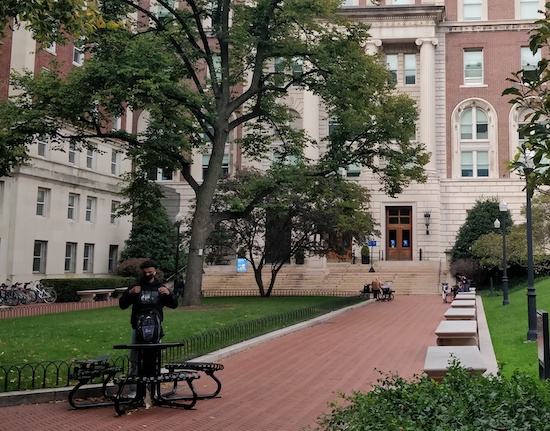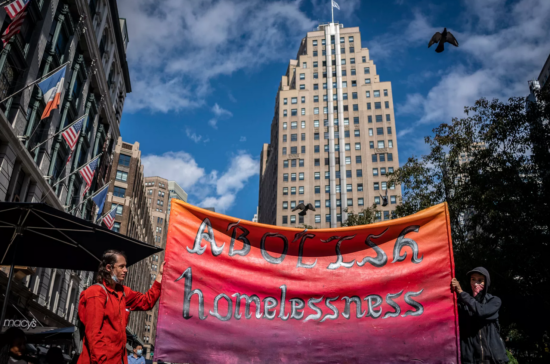
The campus is emptier than usual, and the vast majority of people are wearing masks.
By Megan Zerez
Students and professors are well into the fall semester at Columbia University, and the school’s testing regimen has shown promising results. Case counts remain comfortably below the average for the Upper West Side as a whole, an analysis of city and Columbia data shows.
Most Columbia students are not on campus, and all undergraduate classes are being held online. For those who do head into school buildings, Columbia has a policy mandating routine tests. Weekly positive rates — the percent of people being tested who test positive — have not exceeded 0.25%. The 10025 zipcode, which contains the Morningside campus, currently has a positive test rate just over half a percent and some of the highest testing rates in the city, according to city data. Some people in Morningside Heights had expressed anxiety when students began returning to campus that it would lead to a spike in Covid cases in the area.
The school has reported a total of 21 positive cases since it began testing in June, with 15 of those cases associated with the Morningside Heights campus. (The data does not include cases from the spring, when a student living in a Riverside Drive residence hall died of COVID-19.)
The testing ramped up in mid-August as a limited number of students, faculty and staff returned to campus. Anyone who indicated they expect to visit the campus at least once was required to get a test. So far, the school has conducted almost 31,000 tests.
Visitors were also required to sign and agree to a set of safety guidelines and self-report any symptoms via an app.
But with 60% of graduate coursework and 100% of undergraduate coursework held online, some professors and students opt to not come to campus at all if they can help it.
Dr. Sarah Hansen, who teaches a chemistry laboratory class, says she hasn’t been back to campus since it closed in March.
“I went through the training, I was even going to get tested,” Hansen said. “And then I stopped and I thought, I don’t need to be on campus. And I don’t need to add to the people on campus. I can make the people on campus sick. I don’t need to be there because frankly, I can do my job from here.”
“Here” is the one-bedroom apartment that Hansen shares with her husband and kindergarten-aged daughter, who Hansen says has begun to also take an interest in her classes.
Hansen has retooled much of her class to work with household items, like using tea and cabbage juice to teach a lesson on acid and bases. While the transition hasn’t been easy, Hansen said that the move online has made the class more accessible.
“I have students in my class who would never be able to take my class for a number of different reasons,” Hansen said. “But mostly they couldn’t relocate to New York, they have families. Now it is no longer location based, which is really great.”
Some of those students, she said, have used the experiments they learn in the class to teach their family members during lockdown, which has helped them master the material.
Dr. Talha Siddiqui, who teaches an organic chemistry laboratory class, said she’s also been able to adapt most of her coursework too. But she’s had to go to campus just a handful of times earlier this year to film some lessons involving chemicals that aren’t readily available at home.
“At beginning of the semester, the energy is always intense, and everyone’s there, and it’s crowded,” Siddiqui said. “But it was so quiet – it was very hard to sort of wrap my brain around that this was the beginning of the year and not still the continuation of the summer.”
On a recent Saturday visit to the campus, small groups of mostly-socially distant people enjoyed the fall weather. Mask compliance was near universal.
Siddiqui, who lives in Brooklyn, said that she is able to borrow a family car to make the occasional commute to the Upper West Side.
“Usually my commute to Columbia from my apartment is about 40 minutes,” Siddiqui said. “And it’s 40 minutes on the subway, which at this point, I’m not as comfortable doing. So now it’s 40 minutes in the car.”
For those who live even further afield than Brooklyn, plans have also changed.
Like many first-year students from outside the state, Elena Wilson postponed her move to New York City. Undergraduate students like Wilson do not have any in-person classes and are not permitted to live in the residence halls unless “there is a strong need to be present,” according to the university. Currently, there are only about 900 people living in the residence halls.
Wilson says while she understands the circumstances, it has been challenging to make new friends without being physically on campus.
“I’m pretty shy when it comes to meeting new people, especially talking in a zoom call,” Wilson said. “I can’t introduce myself to others the way I wish to.”
Some students are turning to social media to get to know their new classmates – an Instagram account with the handle @columbiau2024 has ballooned with hundreds of posts introducing incoming freshmen to their peers. Similar accounts from previous years seem to be quickly forgotten after move-in day.
A similar sentiment runs through nearly all the posts: “Can’t wait to meet you all in person, whenever that happens!”
https://www.instagram.com/p/CC4W7lnFCLJ/
University administrators said Friday they expect to announce a provisional plan for the spring semester by mid-November. Anyone who uses the school’s athletic facilities or plans to attend on-campus events can also expect updates around that time. For now, though, those activities remain on hold.









Nice to hear but there’s no one in the school so what do you expect!
Let’s see what happens when the students start returning to their classes in real time….. next year.
I believe Columbia is in the 10027 code rather than 10025.
CC 1956 BUS 1957
Yep, 10027.
You are correct.
I benefit from the 10025 good testing results as I reside here.
1978 BUS 1979
The assumption that undergrads did not relocate to NYC because classes are online is completely false. My building on 110th has many of the apartments filled with undergrads that DO NOT need to be tested and are NOT tested. Typically, first-year students live in dorms, but Columbia wouldn’t allow that, so they pushed them into apartments nearby the school. So far, they have been compliant, although many have guests in the building, so I am still apprehensive to come and go in my building. Take your undergrads back, Columbia, and test!!!
That is not accurate. All students in the university are tested no matter where they residing, especially if they enter campus. That is how they are doing thousands of tests.
I love that a university is taking the pandemic seriously, but I’m not sure a story about low positivity rates for remote learning is worth telling.
5-10 years from now, there may be case studies written about the different approaches taken by Columbia, NYU, Fordham, etc. It will be interesting to see, with the benefit of hindsight, who struck the best balance between “public health” and “student engagement.”
I would also note that the @columbiau2024 account has not been active since August — two months ago. So I’m not sure that quite paints the uplifting, vibrant picture depicted in this piece.
As students deal with going back and forth with in school and classes remotely, why not create groups or clubs in schools that try to create a new sport that keeps players separate at least 6 feet?
A “Sport Establishment Group (SEG) or Club (SEC)” may help students get back together safely outside participating in an a fun activity while complying with Covid-19 social distance mandates.
The sport should be gender neutral. Such sports can help this generation and generations to come.